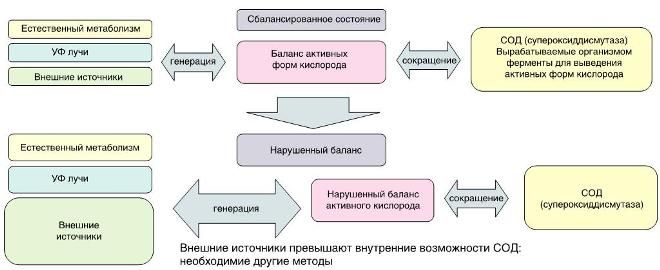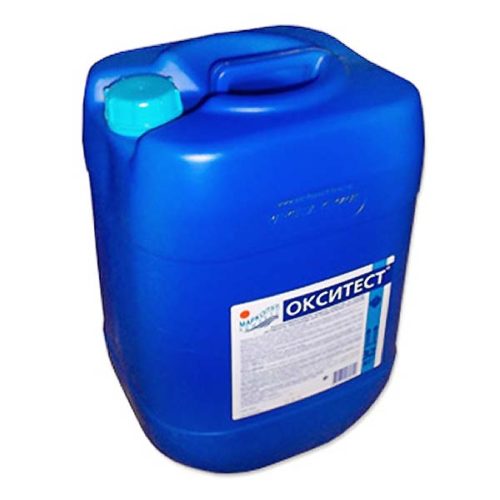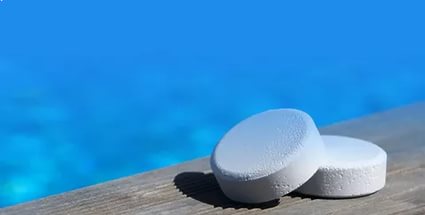|
Highly effective liquid preparation based on active oxygen for pool water disinfection
|
Price: 2100 rubles In stock: many |
Buy | |||||||||||||||||||||||||||||
|
|||||||||||||||||||||||||||||||
| A liquid agent containing active oxygen for the disinfection of pool water. 30 liter canister with pressure relief valve., Vendor code: 11030 | |||||||||||||||||||||||||||||||
"Liquid oxygen"
Active oxygen is a disinfectant for pool water, an alternative to chlorine-based reagents. In terms of disinfection efficiency, active oxygen is not inferior to chlorine, while at the same time having a number of advantages. Active oxygen preparations are odorless and do not cause irritation or allergic reactions. They do not form harmful compounds, for example, chloramines and are used at any pH level.
Active oxygen has antimicrobial activity and successfully destroys various types of bacteria, microorganisms, and inhibits the growth of algae and fungi.
Application
After filling the pool, add 1 liter of the Liquid Oxygen preparation per 10 m³ of pool water.
The current dosage of the “Liquid Oxygen” preparation is carried out continuously using an automatic station or manually. The drug consumption depends on the water temperature in the pool and, on average, is per week: 520 ml at 20-25 ° C, 620 ml at 26 ° C, 700 ml at 27 ° C, 800 ml at 28 ° C, 880 ml at 29 ° C, 900 ml at 30 ° C.
If there are artificial flow devices, a hydromassage or a waterfall in the pool, a larger amount of the “Liquid Oxygen” preparation may be required (the concentration of active oxygen in the pool water should not be lower than 5 mg / liter).
Cautions:
Thoroughly rinse empty containers before disposal with water.
Causes chemical burns.
- Avoid contact with skin and clothing;
- Keep out of the reach of children;
- Never mix with other chemicals;
- In case of contact with eyes, rinse with plenty of water, consult a doctor;
- If swallowed, consult a doctor;
- When working with the drug, wear protective clothing and rubber gloves;
- Store in tightly closed original packaging;
- In a dry room at a temperature of 5-25ºС;
- Shelf life of the drug is 6 months;
- After 6 months, the drug continues to be used, but its dosage and the concentration of active oxygen in the pool water requires additional control.
Ozone is an allotropic modification of oxygen. Gas of a blue color with a specific smell. In nature, ozone is produced in small quantities during a thunderstorm.
Ozone is a powerful oxidizing agent that easily decomposes toxic chemicals into simple, safe compounds.
Ozonation is widely used in medicine, manufacturing, for food processing, and in the production of many laboratory and industrial substances. As a strong oxidizing agent, it is used to sterilize medical devices. As a disinfectant in the purification of water and air, clothing, residential and industrial premises. It destroys extraneous odors well, kills microbes, mold, fungi, viruses.
Ozonation is an environmentally friendly treatment technology. Multiple studies have proved that all products of ozonation are harmless to humans since after contact with polluting chemical and organic substances it turns into ordinary oxygen.
● air purification and disinfection in residential premises of any purpose, bedroom, bathroom, toilet
● purification of drinking water, improves its taste
● saturation with active oxygen of bathtubs, pools, aquariums
● elimination of the smell of tobacco smoke, paint
● specific smell in refrigerators, workshops, cellars
● food processing, increases the shelf life of meat, fish, reduces the concentration of nitrates in vegetables
● use in cosmetic procedures
● destruction of hazardous chemicals, detergents and cleaning products, combustion products
Ozonation is a reliable way to deal with colds, flu epidemics in schools, kindergartens, office premises. When ozonated water is used as food, a strong cleansing effect is observed. Ozonation is an environmentally friendly and effective treatment technology. The ozonizer produces ozone from ordinary oxygen contained in the air. After interacting with active polluting chemical and microbiological substances, ozone turns into ordinary oxygen.
It is proved practically that all products of ozonation without exception are absolutely harmless to humans. The high oxidizing ability of ozone and the formation of oxygen free radicals in many reactions with its participation determine its high toxicity.
All ozone generating devices turn on by timer and should not work in the presence of people.
Oxygen (Latin Oxygenium), a chemical element of the VI group of the periodic table. Under normal conditions, oxygen is a gas without color, odor, or taste. It is difficult to name another element that would play such an important role as oxygen on our planet. On the earth's surface, where photosynthesis takes place and free oxygen dominates, sharply oxidizing conditions are formed. On the contrary, reducing conditions are formed in the cellular system of the human body and free oxygen should be absent. Redox processes in simple water with the participation of oxygen expose the human body to oxidative destruction. So the body wears out, grows old, vital organs lose their function. But another aspect of the problem is associated with the formation of a free oxygen radical. Free radicals, kinetically independent particles characterized by the presence of unpaired electrons. These include an oxygen molecule and derivatives of oxygen. For example: ROO, H2O2, OH, O3, 1O2, etc.
Under normal conditions, the oxygen molecule is diatomic (O2). Dissociation of molecular oxygen in water with the formation of a free radical of oxygen and hydrogen peroxide (rice “formation”) leads, in the future, to a reaction with amino acids that are part of the DNA structure of the human body and the occurrence of mutations (rice “reaction”). 
The danger of active oxygen (radicals) to the human body
Free radicals cause aging
The secrets of aging are in the very depths of the cells, among the molecules that make them up. There are several theories explaining the causes of aging, but one has proved to be the most convincing and better than the others supported by modern evidence. This is the theory of free radicals, and it is formulated as follows: aging occurs when cells are constantly damaged, undergoing the harmful effects of free radicals. Cellular damage accumulates over time until the process reaches a critical moment, and at the end of life we \u200b\u200bare waiting for a “bouquet” of diseases and death.
This is how aging comes with all its consequences. This revelation came to Dr. Denham Harmen, a professor of medicine from the University of Nebraska in 1954. However, like most bold ideas, she remained unattended by practice, until after numerous experiments by Dr. Harmen in the late sixties, other studies began to confirm her case. Now this theory is considered a major step forward in the study of the aging process.
According to Dr. Harmen, diseases such as cancer, heart disease, atherosclerosis, Parkinson's disease, arthritis, Alzheimer's disease are not separate health problems. These are just various forms of the aging process caused by free radicals. Which form is chosen depends on the environment and heredity. Some experts say that 80 to 90% of all degenerative diseases are associated with the action of free radicals. Get rid of free radicals and you slow down the aging process.
Rupture of the transverse bond in the structure of DNA
A free radical is atoms or fragments of molecules that have a separate unpaired electron. This electron gives the radical an unusual chemical aggressiveness, because in order to achieve a stable state, it must take away the electron from another atom. Thanks to this, a radical arises again and the whole reaction chain repeats itself. The reaction of the “radical chain” continues until 2 radicals are connected to each other or it is interrupted by an antioxidant that does not enter into this reaction. Free radicals are continuously formed as by-products of cellular metabolism. For example, with the mitochondrial respiratory chain, about 1-5% of oxygen is not restored to the state of water. At the same time, along with a superoxide radical (this is an ion of an oxygen molecule with an unpaired electron - 1O2), hydrogen peroxide (H2O2) and a particularly aggressive hydroxyl radical (a highly reactive and short-lived OH radical formed by a combination of oxygen and hydrogen atoms) arise. Free radicals directly affect the human genome, causing its numerous mutations. For example, a person has about 10 thousand oxidative DNA damage per cell per day.
Free radical pathology
Peroxide oxidation is a complex chain process of oxygen oxidation of lipid substrates, mainly polyunsaturated fatty acids, including the stages of interaction of lipids with free-radical compounds and the formation of lipid free radicals. Oxygen radicals play a decisive role in initiating peroxidation. As a result of the one-electron reduction of molecular oxygen O2, a superoxide radical anion is formed in the cells. When two superoxide radicals react, a hydrogen peroxide molecule is formed. Activation of peroxidation is a key factor causing damage to the membrane structures of organs and tissues in many diseases (the term "free radical pathology" is adopted for such diseases abroad).
Free radical pathologies include liver diseases, arthritis, atherosclerosis, lung diseases, hypoxic, hyperoxic and reperfusion injuries of organs and tissues, malignant tumors, cataracts, etc.
Pathology for the production of melanin
Under the influence of sunlight, free radicals form in the skin. To neutralize free radicals, special melanocyte cells begin to produce melanin. It is he who is that pigment, the amount of which depends on the intensity of the tan. But protecting itself from the sun by the production of melanin, the body is somewhat late, allowing radicals to adversely affect cells and tissues. In cases of a weakened human immune system, the sun can become a stimulant of undesirable processes, for example, the development of neoplasms - fibroids, warts, moles.
How is active oxygen formed in the body?
Internal sources - the inevitable generation of active oxygen.
- Natural biological metabolism. The process of energy production due to the synthesis of ADP from ATP. ATP - the nucleotide coenzyme adenosine triphosphate is the most important form of conservation of chemical energy in cells. ADP - the nucleotide adenosine diphosphate, is formed as a result of the transfer of the terminal phosphate group of ATP. Example: food digestion - hydrocarbons and fatty acids are used in the synthesis of ATP-ADP.
- UV rays. During the formation and excretion of melanin. Example: Free radicals interfere with the excretion of melanin, so skin discoloration occurs.
- Physiological process. Stress increases adrenaline production, which causes the formation of free radicals.
External sources - present a great danger these days.
- Direct consumption: cigarettes, heavy fatty foods, monosodium glutamate (E 621, however, some manufacturers bashfully hide its presence and indicate “flavoring substance”, “flavoring additives” or “flavor enhancers” in the composition), exhaust gases, etc.
- Indirect consumption: agricultural chemicals, pesticides, trihalogenomethanes, PCBs, etc.
- Radiation: microwave radiation, x-rays, electromagnetic waves of communication media, etc.

Maintaining a balance of free radicals in the human body
In people with normal health conditions, balance is maintained by SOD enzymes.
SOD - superoxide dismutase enzyme, a key enzyme in the series of protein antioxidants that protects the body from the damaging effects of oxygen free radicals.
The French call SOD the "Elixir of Youth" for its ability to prevent premature aging. In our age, people are surrounded by numerous chemicals involved in the generation of free radicals. Thus, the threat of imbalance in the active forms of oxygen is growing. Additional assistance is needed in the body in the process of removing harmful elements. 
Methods to restore balance in the human body
- Conventional methods
Medications that enhance the function of SOD. They are vitamins C, E, etc.
Healthy foods, such as milk, fresh fruits, etc.
Ionized alkaline water with low Oxidation Reduction Potential and high pH. - Our method is pi-water
Pi-water is known as life-enhancing water. It is widely known in developed countries such as Japan.
For use chlorine, active oxygen and bromine-containing drugs. In this article we will analyze how active oxygen for a pool differs from its analogues and what are its advantages.
General tool information
When people talk about cleaning a pool without chlorine, most often they mean the use of active oxygen. The most significant reason for abandoning popular chlorine-containing drugs is the smell and effect on the mucous membranes. But we will analyze the advantages and disadvantages in detail a little later.

The main purpose of active oxygen is the destruction of viruses, microbes, fungi and other microorganisms in water. With algae, he can not fight, so add an additional remedy.
And this remedy is algicide. This tool dissolves the protective membrane of algae cells, and after that, active oxygen will cope with the bacterium without any problems.
Let’s now talk about the pros and cons of this method of combating living microorganisms, and whether it should be used instead of chlorine.
Advantages and disadvantages of the substance
Let's start a good one - we’ll list and analyze in detail the strengths of active oxygen for a pool:- Not irritating to the mucous membranes. This greatly increases the comfort for bathing people;
- There is no smell;
- Does not affect the ph level. This allows you to once adjust the acid-base balance and not be afraid of its sudden changes;
- It quickly dissolves in water and quickly disinfects all water;
- Does not create foam on the surface;
- Use with a small addition of chlorine is possible.
Yes, the benefits are really significant. But why then is chlorine the most popular pool water care product? And here you can not do without a fly in the ointment:
- Active oxygen belongs to the second hazard class. It is not scary if you strictly follow the instructions. But in case of your mistake when dosing, the consequences can be quite serious;
- The tool is very active, so more new doses are required. And at a water temperature of more than 28 degrees, the effectiveness of the drug is significantly reduced;
- Oxygen promotes the development of algae. On many sites you will see reverse information, but from manufacturers there is a recommendation for the mandatory use of algaecide;
- High cost when compared with chlorine;
- Sometimes you still have to add chlorine.
As you can see, water purification with active oxygen has both attractive advantages and, at the same time, repulsive disadvantages. We recommend using chlorine proven over the years. But if the smell, slight irritation and dry skin is unacceptable for you, then you should pay attention to its analogues.
How to add active oxygen to water

On sale, this tool is presented in 3 versions: tablets, powder, liquid and granules.
When adding funds, no one should be in the water. The substance needs to be given several hours for even distribution. Some add chemistry at night so that the pool is ready by morning.
The first two are added directly to the pool in the proportions that are indicated in the instructions for the drug. Liquid and granules are dissolved in a bucket and poured into water along the entire perimeter along the sides. This method will be distributed and begin to work much faster than the direct addition of tablets and powder to the bowl.
To purify water with active oxygen as efficiently as possible, you need to consider some nuances. They are not complicated, but their use will significantly help save money and effort.
Firstly, always follow the main indicator - ph. This is an acid-base balance, and the work of chemical additives depends on it to a greater extent. Also always pay attention to temperature. If it is too warm, then microorganisms will develop much faster, and even an increased dose of a disinfectant will not cope with them.
Chemical additives should be poured into the bowl regularly. Make a calendar for yourself in which you will note what and how much you added to the pool water.
Do not forget to use a filter and an underwater vacuum cleaner. Watch the filter equipment for proper operation, and regularly collect dirt from the bottom of the bowl with a vacuum cleaner.
Thematic video
Today we examined how to purify water with active oxygen for the pool. Particular attention was paid to its advantages and disadvantages, so that you understand whether it is necessary to abandon the usual chlorine or is it better to leave it as it is.
You just have to think again, read and make a decision.
